Enhanced Field Emission of Single-Wall Carbon Nanotube Cathode Prepared by Screen Printing with a Silver Paste Buffer Layer
Abstract
:1. Introduction
2. Materials and Methods
3. Results and Discussion
3.1. Structural Characterization
3.2. Field Emission Characterization
4. Conclusions
Author Contributions
Funding
Institutional Review Board Statement
Informed Consent Statement
Data Availability Statement
Conflicts of Interest
References
- Manohara, H.M.; Toda, R.; Lin, R.H.; Liao, A.; Bronikowski, M.J.; Siegel, P.H. Carbon nanotube bundle array cold cathodes for THz vacuum tube sources. J. Infrared Millim. Terahertz Waves 2009, 30, 1338–1350. [Google Scholar] [CrossRef]
- Kim, H.J.; Jang, L.B.; Seo, W.B.; Choi, J.J. Experimental investigation of broadband vaned helix traveling-wave tube. Jpn. J. Appl. Phys. 2006, 45, 292–299. [Google Scholar] [CrossRef]
- Chong, C.K.; Menninger, W.L. Latest advancements in high-power millimeter-wave helix TWTs. IEEE Trans. Plasma Sci. 2010, 38, 1227–1238. [Google Scholar] [CrossRef]
- Whaley, D.R.; Gannon, B.M.; Smith, C.R.; Armstrong, C.M.; Spindt, C.A. Application of field emitter arrays to microwave power amplifiers. IEEE Trans. Plasma Sci. 2000, 28, 727–747. [Google Scholar] [CrossRef]
- Kim, H.J.; Choi, J.J.; Han, J.H.; Park, J.H.; Yoo, J.B. Design and field emission test of carbon nanotube pasted cathodes for traveling-wave tube applications. IEEE Trans. Electron Devices 2006, 53, 2674–2680. [Google Scholar] [CrossRef]
- Han, J.H.; Lee, T.Y.; Kim, D.Y.; Yoo, J.B.; Park, C.Y.; Choi, J.J.; Jung, T.; Han, I.T.; Kim, J.M. Field emission properties of carbon nanotubes grown on Co/TiN coated Ta substrate for cathode in microwave power amplifier. Diam. Relat. Mater. 2004, 13, 987–993. [Google Scholar] [CrossRef]
- Yuan, X.; Zhang, Y.; Yang, H.; Li, X.; Xu, N.; Deng, S.; Yan, Y. A Gridded High-Compression-Ratio Carbon Nanotube Cold Cathode Electron Gun. IEEE Electron Device Lett. 2015, 36, 399–401. [Google Scholar] [CrossRef]
- Whaley, D.R.; Duggal, R.; Armstrong, C.M.; Bellew, C.L.; Holland, C.E.; Spindt, C.A. 100 W operation of a cold cathode TWT. IEEE Trans. Electron Devices 2009, 56, 896–905. [Google Scholar] [CrossRef]
- Spindt, C.; Holland, C.E.; Schwoebel, P.R. 11.1: A reliable improved spindt cathode design for high currents. In Proceedings of the 2010 IEEE International Vacuum Electronics Conference (IVEC), Monterey, CA, USA, 18–30 May 2010; pp. 201–202. [Google Scholar] [CrossRef]
- Lijima, S. Helical microtubules of graphitic carbon. Nature 1991, 354, 56–58. [Google Scholar] [CrossRef]
- Lee, S.-B.; Teo, K.B.K.; Robinson, L.A.W.; Teh, A.S.; Chhowalla, M.; Hasko, D.G.; Amaratunga, G.A.J.; Milne, W.I.; Ahmed, H. Characteristics of multiwalled carbon nanotube nanobridges fabricated by poly(methylmethacrylate) suspended dispersion. J. Vac. Sci. Technol. B Microelectron. Nanometer Struct. 2002, 20, 2773–2776. [Google Scholar] [CrossRef]
- Teo, K.B.K.; Minoux, E.; Hudanski, L.; Peauger, F.; Schnell, J.P.; Gangloff, L.; Legagneux, P.; Dieumegard, D.; Amaratunga, G.A.J.; Milne, W.I. Microwave Devices-Carbon nanotubes as cold cathodes. Nature 2005, 437, 967–968. [Google Scholar] [CrossRef]
- Zeng, B.; Xiong, G.; Chen, S.; Wang, W.Z.; Wang, D.Z.; Ren, Z.F. Enhancement of field emission of aligned carbon nanotubes by thermal oxidation. Appl. Phys. Lett. 2006, 89, 223119. [Google Scholar] [CrossRef]
- Liu, J.; Zeng, B.; Wang, X.; Wang, W.; Shi, H. One-step growth of vertical graphene sheets on carbon nanotubes and their field emission properties. Appl. Phys. Lett. 2013, 103, 053105. [Google Scholar] [CrossRef]
- André, F.; Ponard, P.; Rozier, Y.; Bourat, C.; Gangloff, L.; Xavier, S. 7.1:TWT and X-ray devices based on carbon nano-tubes. In Proceedings of the 2010 IEEE International Vacuum Electronics Conference (IVEC), Monterey, CA, USA, 18–30 May 2010; pp. 83–84. [Google Scholar] [CrossRef]
- Li, X.; Chen, B.; Feng, Y.; Zhang, Y.; Deng, S.; Feng, J. Beam Test of a Novel CNT Cathode-Based Electron Gun Assembled in a TWT. IEEE Trans. Electron Devices 2019, 66, 2382–2388. [Google Scholar] [CrossRef]
- Yuan, X.; Zhu, W.; Zhang, Y.; Xu, N.; Yan, Y.; Wu, J.; Shen, Y.; Chen, J.; She, J.; Deng, S. A Fully-Sealed Carbon-Nanotube Cold-Cathode Terahertz Gyrotron. Sci. Rep. 2016, 6, 32936. [Google Scholar] [CrossRef] [Green Version]
- Cho, Y.; Song, H.; Choi, G.; Kim, D. A simple method to fabricate high-performance carbon nanotube field emitters. J. Electroceram. 2006, 17, 945–949. [Google Scholar] [CrossRef]
- Majeed Khan, M.A.; Khan, W.; Kumar, A.; Alhazaa, A.N. Plasma enhanced chemical vapour deposition growth and physical properties of single-walled carbon nanotubes. Mater. Lett. 2018, 219, 269–272. [Google Scholar] [CrossRef]
- Kim, Y.C.; Sohn, K.H.; Cho, Y.M.; Yoo, E.H. Vertical alignment of printed carbon nanotubes by multiple field emission cycles. Appl. Phys. Lett. 2004, 84, 5350–5352. [Google Scholar] [CrossRef]
- Shang, X.F.; Zhou, J.J.; Zhao, P.; Li, Z.H.; Qu, S.; Gu, Z.Q.; Xu, Y.B.; Wang, M. The enhanced field-emission properties of screen-printed single-wall carbon-nanotube film by electrostatic field. Appl. Surf. Sci. 2010, 256, 2005–2008. [Google Scholar] [CrossRef]
- Vink, T.J.; Gillies, M.; Kriege, J.C.; van de Laar, H.W.J.J. Enhanced field emission from printed carbon nanotubes by mechanical surface modification. Appl. Phys. Lett. 2003, 83, 3552–3554. [Google Scholar] [CrossRef]
- Kim, J.M.; Choi, W.B.; Lee, N.S.; Jung, J.E. Field emission from carbon nanotubes for displays. Diam. Relat. Mater. 2000, 9, 1184–1189. [Google Scholar] [CrossRef]
- Hosono, A.; Shiroishi, T.; Nishimura, K.; Abe, F.; Shen, Z.; Nakata, S.; Okuda, S. Emission characteristics of printed carbon nanotube cathodes after laser treatment. J. Vac. Sci. Technol. B Microelectron. Nanometer Struct. 2006, 24, 1423–1427. [Google Scholar] [CrossRef]
- Liu, J.; Zeng, B.; Wu, Z.; Sun, H. Enhanced field electron emission of graphene sheets by CsI coating after electrophoretic deposition. ACS Appl. Mater. Interfaces 2012, 4, 1219–1224. [Google Scholar] [CrossRef] [PubMed]
- Zhu, W.; Bower, C.; Zhou, O.; Kochanski, G.; Jin, S. Large current density from carbon nanotube field emitters. Appl. Phys. Lett. 1999, 75, 873–875. [Google Scholar] [CrossRef]
- Lin, Z.L.; Wang, X.J. Field Electron Emission. In Cathode Electronics; National Defense Industry Press: Beijing, China, 2013; pp. 98–115. [Google Scholar]
- Jiang, R.; Zeng, B.; Liu, J.; Chai, X.; Chen, T.; Wu, Z.; Zhang, X.; Yang, K. Enhanced field electron emission of single-walled carbon nanotubes prepared by imprinting technique. J. Alloy. Compd. 2020, 816, 152669. [Google Scholar] [CrossRef]
- Forbes, R.G. Field emission: New theory for the derivation of emission area from a Fowler-Nordheim plot. J. Vac. Sci. Technol. B 1999, 17, 526–533. [Google Scholar] [CrossRef]
- Forbes, R.G. Extraction of emission parameters for large-area field emitters, using a technically compete Fowler-Nordheim-type equation. Nanotechnology 2012, 23, 095706. [Google Scholar] [CrossRef] [Green Version]
- Forbes, R.G.; Fischer, A.; Mousa, M.S. Improved approach to Fowler-Nordheim plot analysis. J. Vac. Sci. Technol. B 2013, 31, 02B103. [Google Scholar] [CrossRef] [Green Version]
- Liu, X.; Wu, Y.; Su, Y.; Zhao, B.; Wang, Y.; Liu, C.; Zhang, Y. Enhanced electron field emission characteristics of single-walled carbon nanotube films by ultrasonic bonding. Phys. E Low Dimens. Syst. Nanostruct. 2014, 63, 165–168. [Google Scholar] [CrossRef]
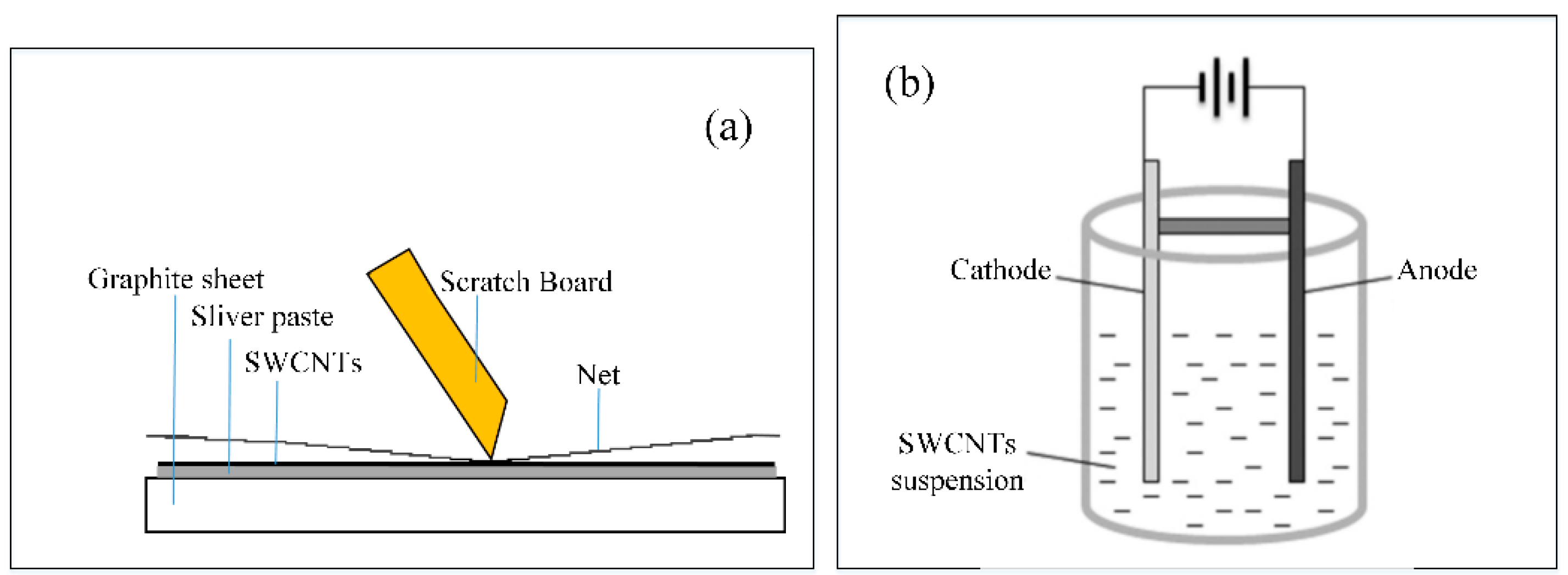

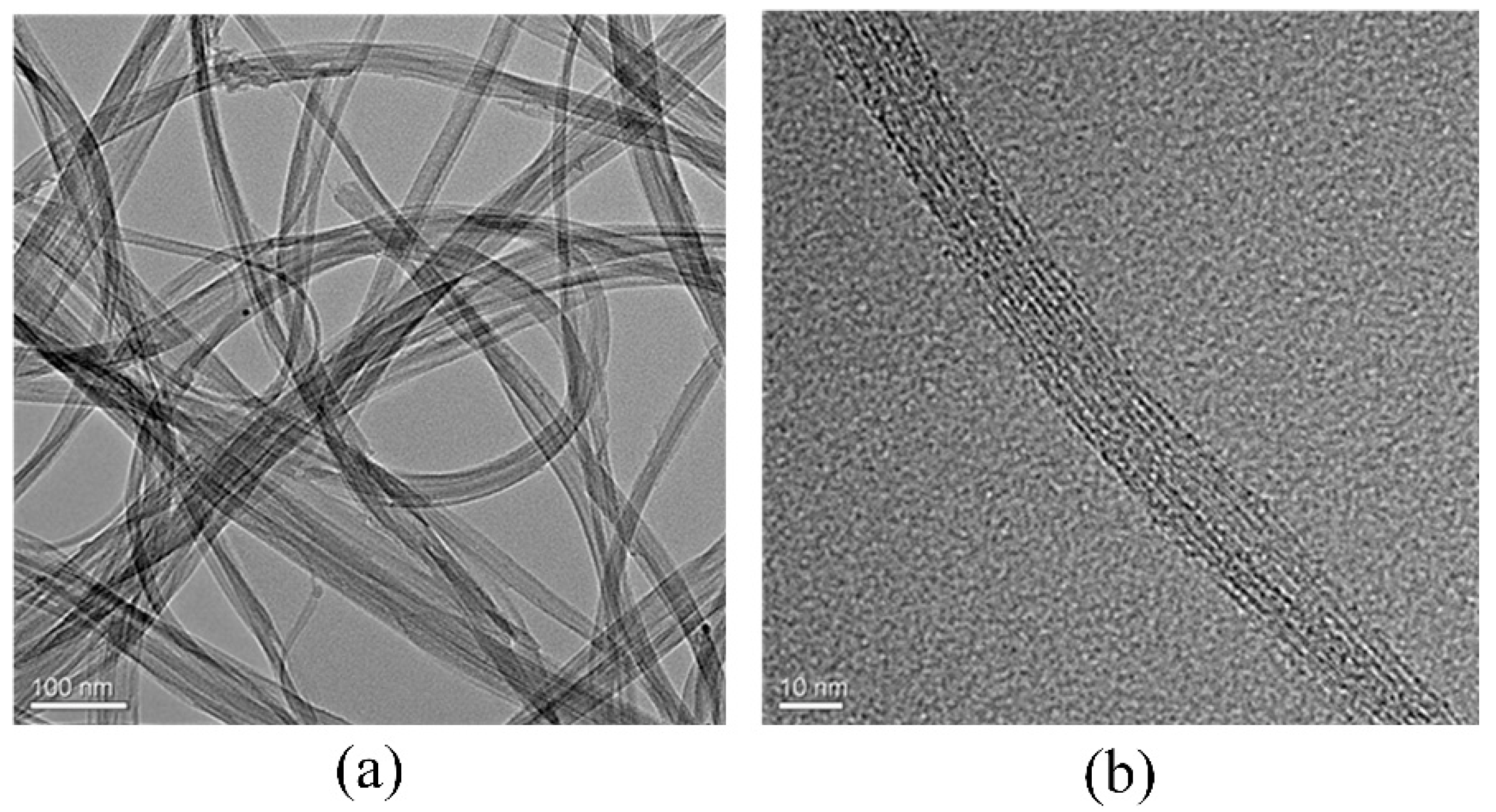

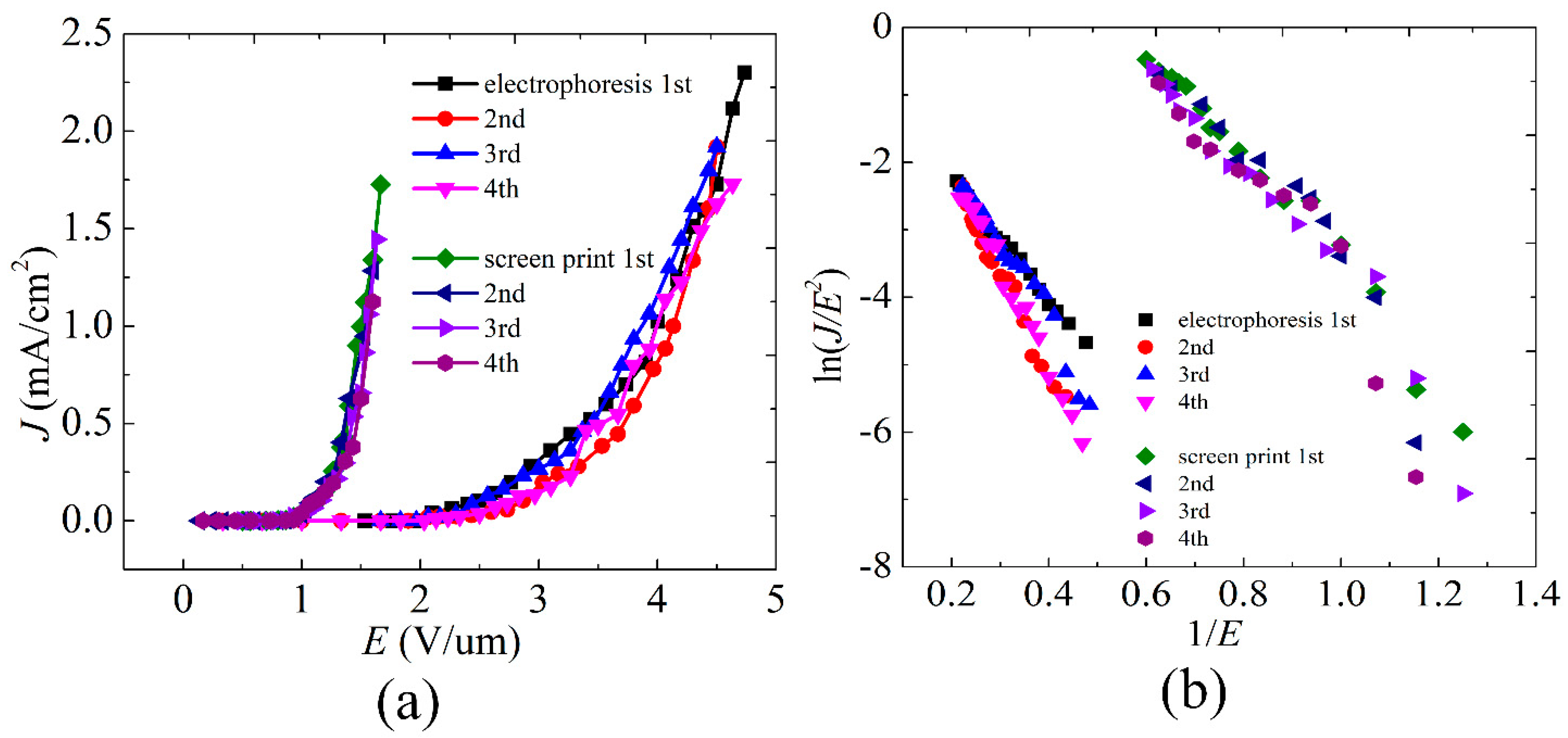
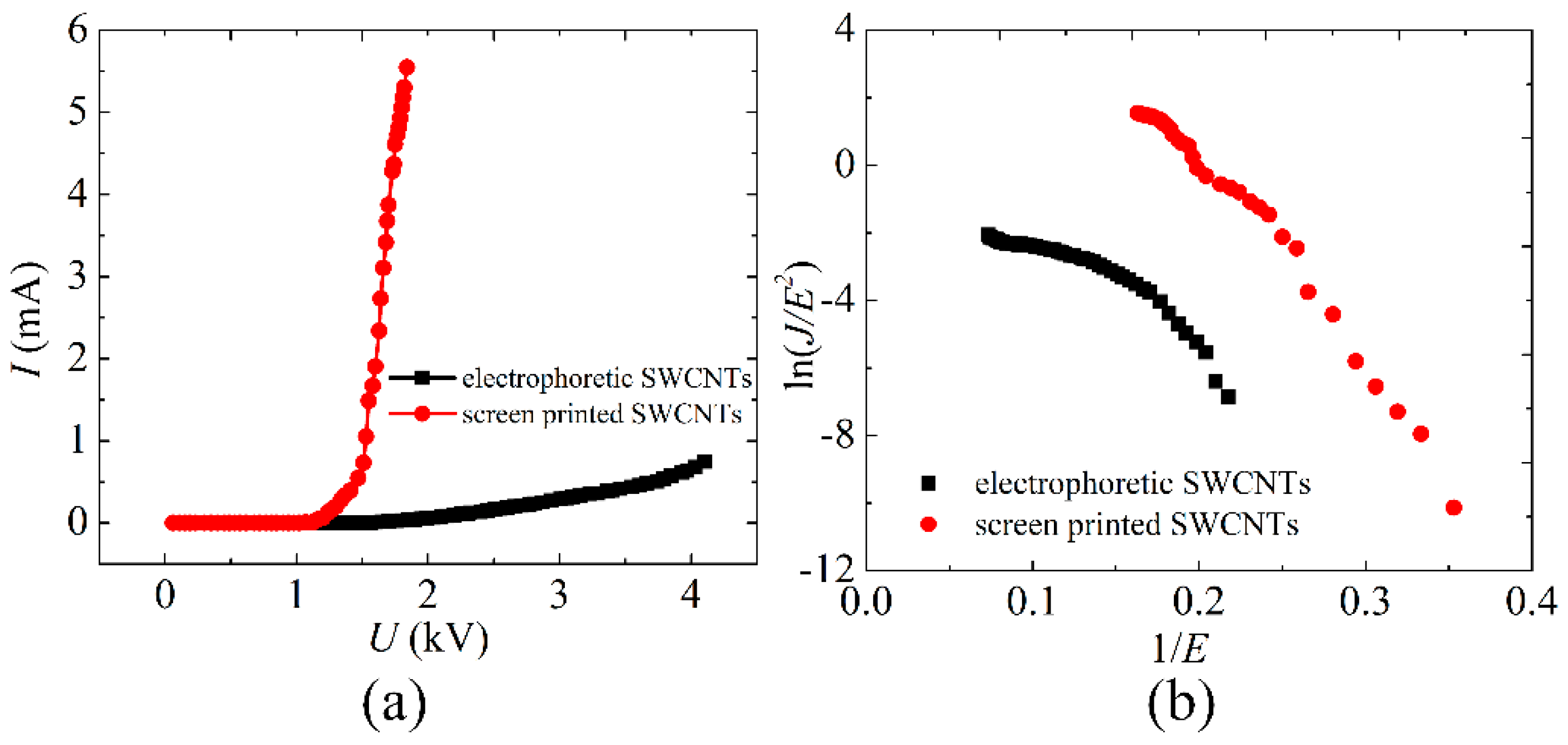
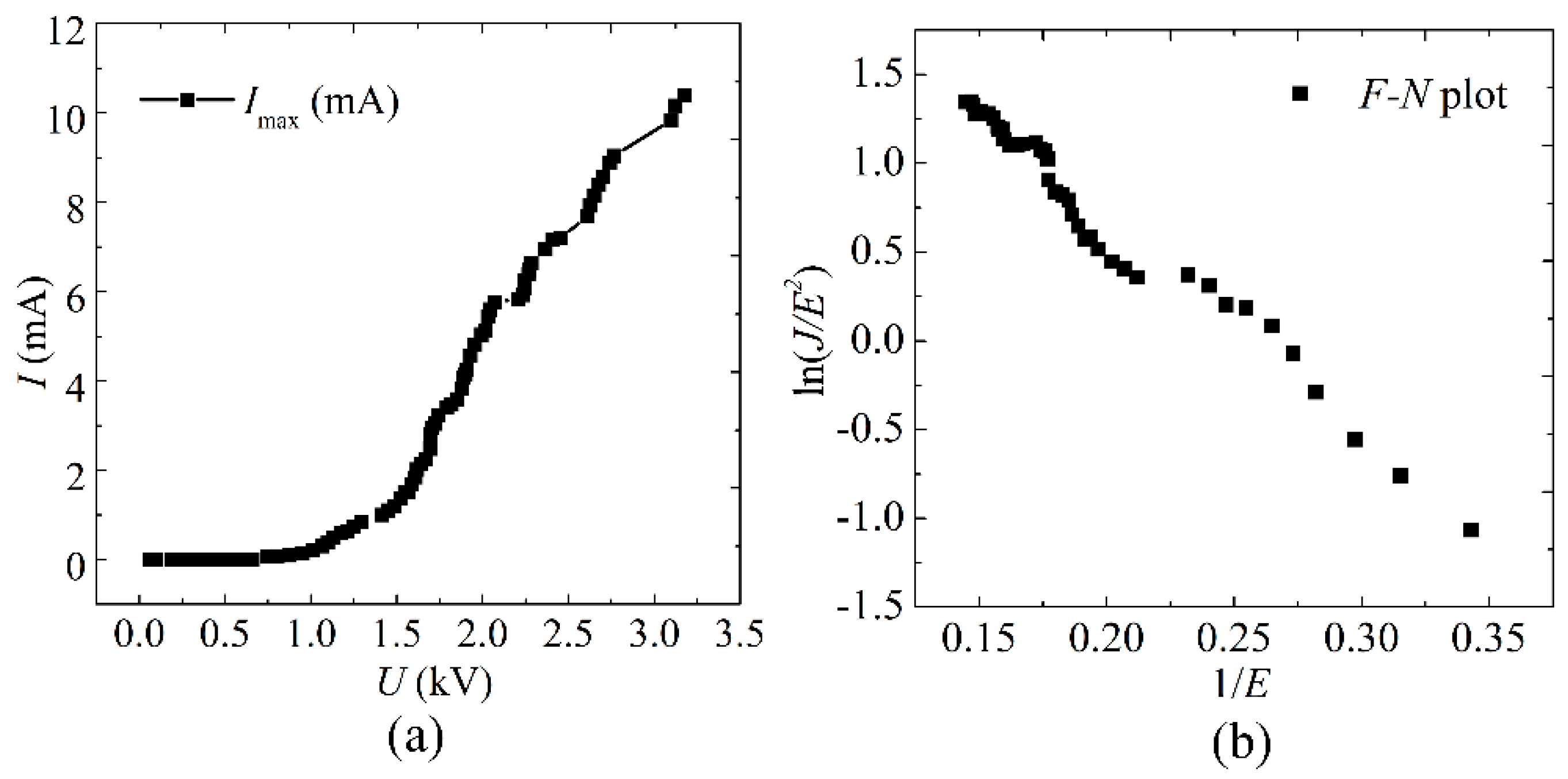
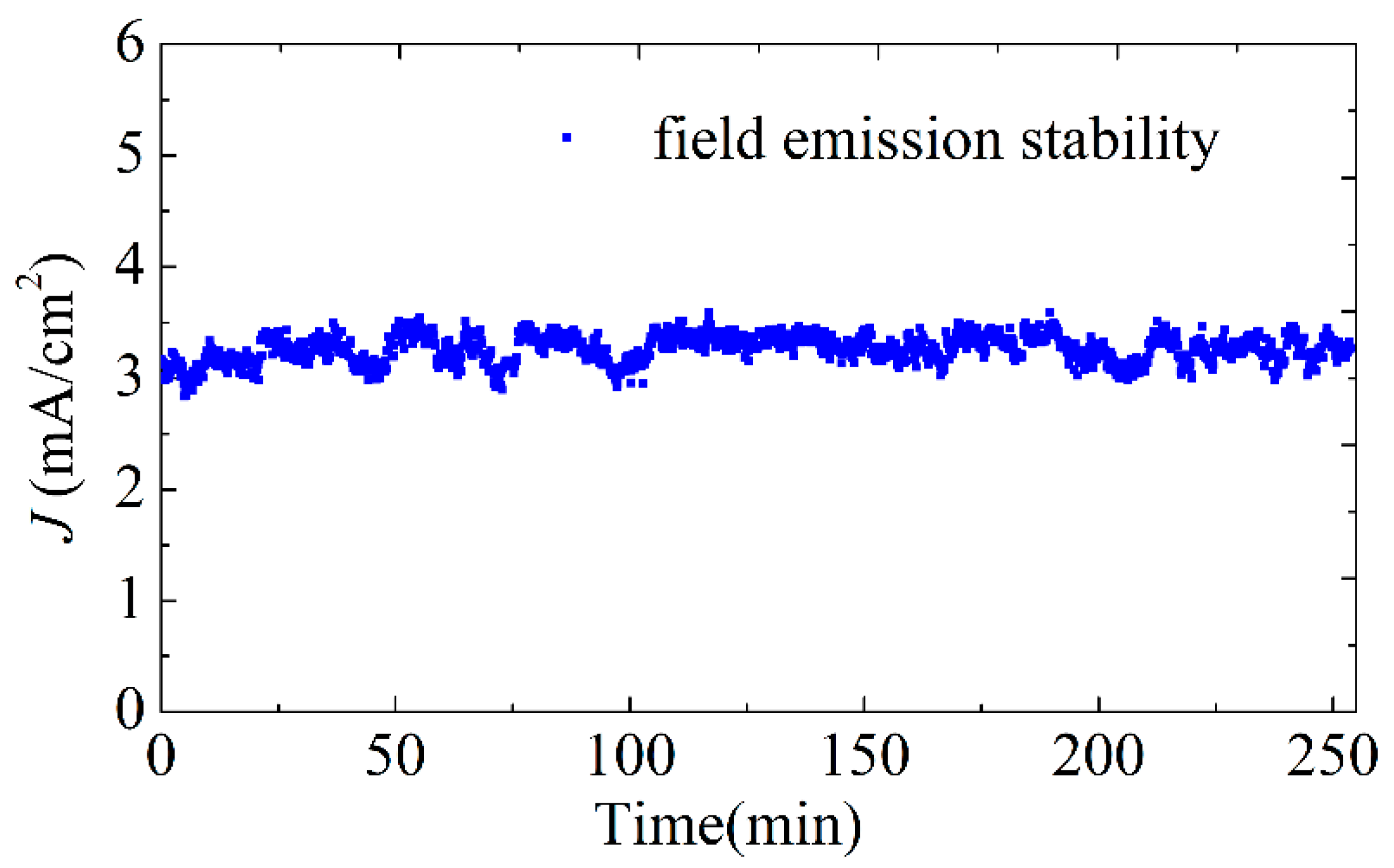
| Screen Printed SWCNTs Cathode | Turn-On Field/Threshold Field (V/μm) | Electrophoretic SWCNTs Cathode | Turn-On Field/Threshold Field (V/μm) |
|---|---|---|---|
| 1st | 0.9/1.5 | 1st | 2.0/4.0 |
| 2nd | 0.9/1.55 | 2nd | 2.0/4.1 |
| 3rd | 0.89/1.56 | 3rd | 2.0/3.8 |
| 4th | 0.95/1.57 | 4th | 2.1/4.0 |
Publisher’s Note: MDPI stays neutral with regard to jurisdictional claims in published maps and institutional affiliations. |
© 2022 by the authors. Licensee MDPI, Basel, Switzerland. This article is an open access article distributed under the terms and conditions of the Creative Commons Attribution (CC BY) license (https://creativecommons.org/licenses/by/4.0/).
Share and Cite
Jiang, R.; Liu, J.; Yang, K.; Zhao, J.; Zeng, B. Enhanced Field Emission of Single-Wall Carbon Nanotube Cathode Prepared by Screen Printing with a Silver Paste Buffer Layer. Nanomaterials 2022, 12, 165. https://doi.org/10.3390/nano12010165
Jiang R, Liu J, Yang K, Zhao J, Zeng B. Enhanced Field Emission of Single-Wall Carbon Nanotube Cathode Prepared by Screen Printing with a Silver Paste Buffer Layer. Nanomaterials. 2022; 12(1):165. https://doi.org/10.3390/nano12010165
Chicago/Turabian StyleJiang, Ruirui, Jianlong Liu, Kaiqiang Yang, Jing Zhao, and Baoqing Zeng. 2022. "Enhanced Field Emission of Single-Wall Carbon Nanotube Cathode Prepared by Screen Printing with a Silver Paste Buffer Layer" Nanomaterials 12, no. 1: 165. https://doi.org/10.3390/nano12010165
APA StyleJiang, R., Liu, J., Yang, K., Zhao, J., & Zeng, B. (2022). Enhanced Field Emission of Single-Wall Carbon Nanotube Cathode Prepared by Screen Printing with a Silver Paste Buffer Layer. Nanomaterials, 12(1), 165. https://doi.org/10.3390/nano12010165






